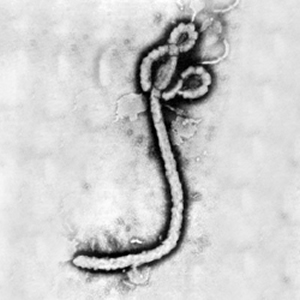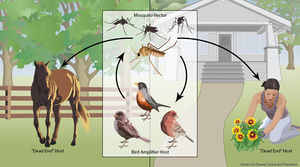West Nile Virus in Birds: Difference between revisions
| Line 33: | Line 33: | ||
<br> <br> | <br> <br> | ||
== | ==Species Susceptibilities and Competence== | ||
<br> | <br> | ||
{| width="400" border="1" | |||
| width="100" height="24" | <b>Species</b> | |||
| width="100" | <b>Reservoir Competence Index</b>* | |||
|- | |||
|Blue Jay | |||
|2.55 | |||
|- | |||
|Common Grackle | |||
|2.04 | |||
|- | |||
| House Finch | |||
|1.76 | |||
|- | |||
|American Crow | |||
|1.62 | |||
|- | |||
|House Sparrow | |||
|1.59 | |||
|- | |||
|Ring-billed Gull | |||
|1.26 | |||
|- | |||
|Black-billed Magpie | |||
|1.08 | |||
|- | |||
|American Robin | |||
|1.08 | |||
|- | |||
|Red-winged Blackbird | |||
|0.99 | |||
|- | |||
|American Kestrel | |||
|0.93 | |||
|- | |||
|Great Horned Owl | |||
|0.88 | |||
|- | |||
|Killdeer | |||
|0.87 | |||
|- | |||
|Fish Crow | |||
|0.73 | |||
|- | |||
|Mallard | |||
|0.48 | |||
|- | |||
|European Starling | |||
|0.22 | |||
|- | |||
|Mourning Dove | |||
|0.19 | |||
|- | |||
|Northern Flicker | |||
|0.06 | |||
|- | |||
|Canada Goose | |||
|0.03 | |||
|- | |||
|Rock Dove | |||
|0 | |||
|- | |||
|American Coot | |||
|0 | |||
|- | |||
|Japanese Quail | |||
|0 | |||
|- | |||
|Northern Bobwhite | |||
|0 | |||
|- | |||
|Ring-necked Pheasant | |||
|0 | |||
|- | |||
|Monk Parakeet | |||
|0 | |||
|} | |||
<br>*based on susceptibility, mean infectiousness and mean duration (days) | |||
==Section 3== | ==Section 3== | ||
Revision as of 00:03, 10 March 2014
West Nile Virus, of the family Flaviviridae, is a zoonotic disease that infects many species, including humans, throughout the world. Birds are the virus’s primary natural reservoir, where they act as the amplifier host. but their host competency (their ability to perpetuate the virus' development and spread) and response to infection varies between species; they can have diverging levels of viremia, viral shedding, clinical signs, and morbidity. Many factors may affect a particular organism and/or species’ susceptibility and response to infection, based on their life histories, immune-response capabilities, previous immunities, breeding systems, genetics, and stress levels. Birds vary widely in how they are affected by West Nile Virus.
Initial Infection
At right is a sample image insertion. It works for any image uploaded anywhere to MicrobeWiki. The insertion code consists of:
Double brackets: [[
Filename: Ebola virus 1.jpeg
Thumbnail status: |thumb|
Pixel size: |300px|
Placement on page: |right|
Legend/credit: Electron micrograph of the Ebola Zaire virus. This was the first photo ever taken of the virus, on 10/13/1976. By Dr. F.A. Murphy, now at U.C. Davis, then at the CDC.
Closed double brackets: ]]
Birds may become infected with West Nile Virus in multiple ways. The most common occurrence is through a mosquito vector. However, studies have shown that they may contract the infection through eating infected organisms, direct contact, or fecal contact.
Subsection: Mosquito Vectors: Blah blah mosquitos usually something something Oral Transmission: By ingesting infected mice or other birds, a carnivorous bird may present viremia.
Other examples:
Bold
Italic
Subscript: H2O
Superscript: Fe3+
Overall paper length should be 3,000 words, with at least 3 figures with data.
Species Susceptibilities and Competence
| Species | Reservoir Competence Index* |
| Blue Jay | 2.55 |
| Common Grackle | 2.04 |
| House Finch | 1.76 |
| American Crow | 1.62 |
| House Sparrow | 1.59 |
| Ring-billed Gull | 1.26 |
| Black-billed Magpie | 1.08 |
| American Robin | 1.08 |
| Red-winged Blackbird | 0.99 |
| American Kestrel | 0.93 |
| Great Horned Owl | 0.88 |
| Killdeer | 0.87 |
| Fish Crow | 0.73 |
| Mallard | 0.48 |
| European Starling | 0.22 |
| Mourning Dove | 0.19 |
| Northern Flicker | 0.06 |
| Canada Goose | 0.03 |
| Rock Dove | 0 |
| American Coot | 0 |
| Japanese Quail | 0 |
| Northern Bobwhite | 0 |
| Ring-necked Pheasant | 0 |
| Monk Parakeet | 0 |
*based on susceptibility, mean infectiousness and mean duration (days)
Section 3
Include some current research in each topic, with at least one figure showing data.
Further Reading
[Sample link] Ebola Hemorrhagic Fever—Centers for Disease Control and Prevention, Special Pathogens Branch
References
Edited by (your name here), a student of Nora Sullivan in BIOL168L (Microbiology) in The Keck Science Department of the Claremont Colleges Spring 2014.


